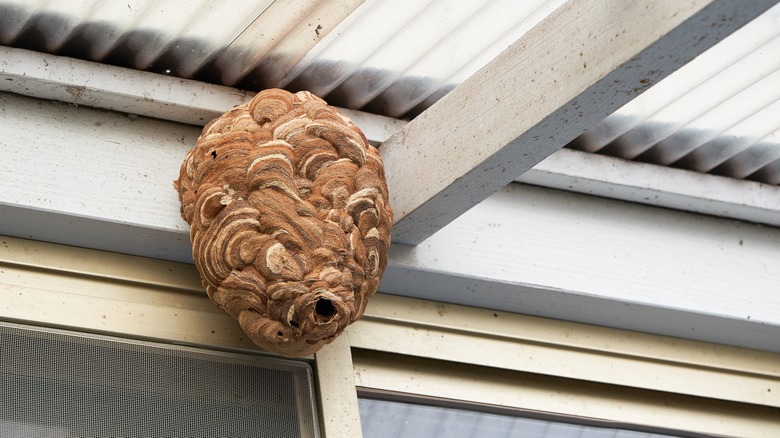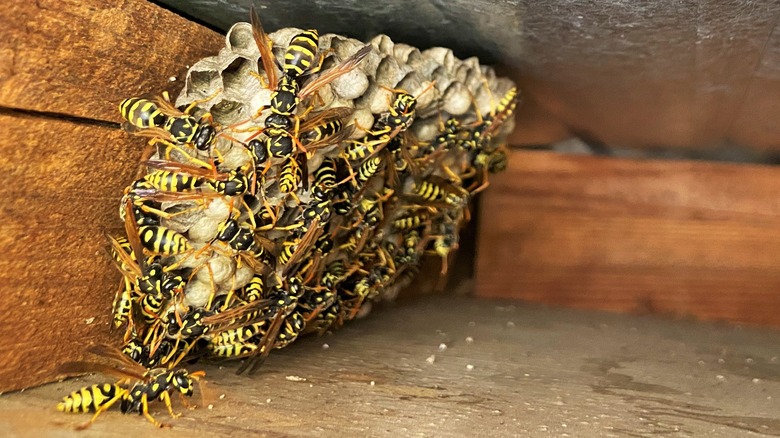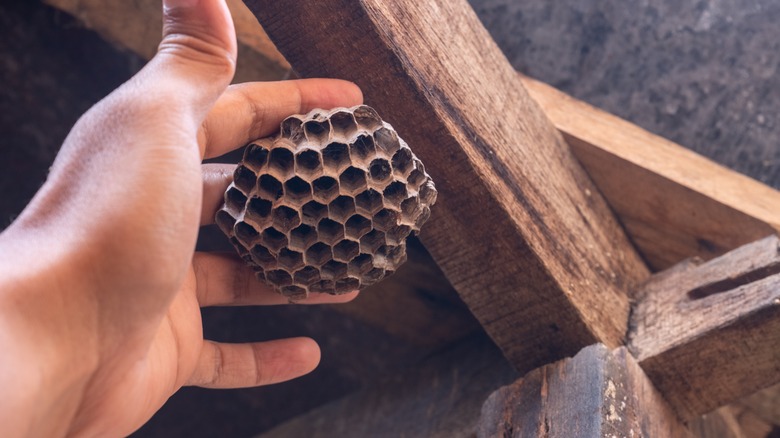Don't Mistake This Stinging Pest's Nest For A Termite Problem
So you've discovered what appear to be hardened mud blobs around your property and it's causing a bit of concern. That concern might be amplified when you see unusual winged ants emerging from them. Your mind may jump to termites, but hold on. These structures might be the handiwork of wasps. Wasps and termites, both known for their remarkable nest-building skills, often surprise people with the similarities in their construction. There's limited information as to why their nests resemble each other, and it might just be a simple case of convergent evolution, a process where unrelated species develop similar traits or features due to similar environmental pressures or needs. This phenomenon is especially visible in certain wasp species, such as the Mud Dauber wasps, whose nest constructions resemble the mud tubes of termites.
As a part of the Vespidae family, these wasps build their nests from mud, but they're usually tubular and can be found on walls, eaves, or even under bridges. These wasp nests mimic termite nests in appearance, primarily due to the use of similar building materials (mud or clay). However, it's essential to differentiate between these nests, as the inhabitants have vastly different behaviors and implications for both humans and the environment. When identifying wasp activity around your property, you need to be careful. Remember, wasps can be defensive and sting, so you need to keep a safe distance and weigh the risks before deciding on ways to get rid of wasps yourself.
Differentiating wasp nests from termite nests
While wasp and termite nests may look similar at first glance, there are several key differences to watch out for. One of the most noticeable differences is the location and the presence of the nests themselves. Wasp nests are often found in more exposed areas, like under eaves or on walls. Termite nests, on the other hand, are typically hidden within wooden structures or underground, with only mud tubes visible on surfaces. The structures of the nests also vary. Termite nests are narrower and longer. Some termite species build larger and more complex structures, with a network of tunnels and chambers to accommodate the colony. On the other hand, mud dauber nests resemble cylinders, which they build over time.
Understanding what species a nest belongs to a wasp or termite is crucial for several reasons. Firstly, the pest control approach for each situation is significantly different. Wasps are important pollinators and play a role in controlling other insect populations. On the other hand, termites are known for causing significant structural damage to buildings, necessitating different control measures. Moreover, the health risks associated with each insect vary. Wasps can sting and are a concern for individuals with allergies, but they generally do not pose a threat to physical structures.
Tackling the wasp nest: effective removal strategies
The most common method for getting rid of wasps is using insecticides. You'll find various products in stores like the reliable brands Raid and Spectracide. When planning to remove the nest, timing is everything. It's best to do it in the evening when wasps are more relaxed, which minimizes the risk of getting stung. Before you start, though, gear up for safety. Wear protective clothing like long sleeves, pants, gloves, and a hat. You'll also need a flashlight to illuminate the nest area.
Approach the nest slowly and calmly, as any sudden movements can trigger the wasps into defense mode. Observe the wasps from a safe distance, about 15 feet away. If you have a vacuum with a long hose and nozzle, it can be handy for removing any wasps in your way. Once you've vacuumed as many as you can, spray the insecticide, making sure to aim carefully and follow the product's instructions. After the insecticide has done its work, the next step is to break off the nest, which you can do using a broomstick. Be sure to knock the nest down completely and dispose of it properly to prevent any wasps from returning. Your comfort with the situation is among the things to consider before calling pest control professionals, so don't hesitate to reach out if you're feeling apprehensive.


